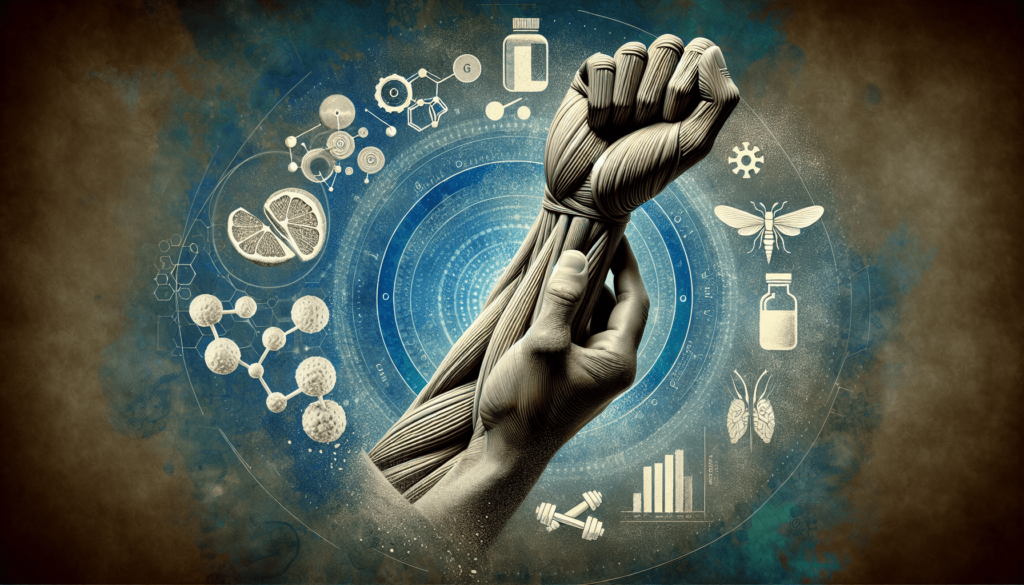Imagine getting older and realizing that your once strong and lean muscles are slowly fading away. It’s a common concern among older adults, and it’s called sarcopenia. But here’s the good news – there are ways to fight back and restore your muscle loss. In this article, you will discover the best strategies, products, and tips to help you regain your muscle strength and vitality. So, if you’re ready to reclaim your muscle power and enjoy an active lifestyle, keep reading because help is on the way!

This image is property of pixabay.com.
Understanding Muscle Loss
Muscle loss, also known as muscle atrophy, occurs when the size and strength of our muscles decrease. This can be caused by a variety of factors, including aging, lack of physical activity, poor nutrition, and certain medical conditions. Understanding the causes, effects, and factors affecting muscle loss is essential in devising effective strategies for prevention and reversal.
Causes of muscle loss
There are several causes of muscle loss, each with their own unique impact on our bodies. Aging is a significant factor, as we naturally experience a decline in muscle mass and strength as we grow older. Inactivity or a sedentary lifestyle can also contribute to muscle loss, as our muscles require regular physical activity to maintain their size and functionality. Furthermore, certain medical conditions such as muscular dystrophy, cancer, and chronic obstructive pulmonary disease (COPD) can result in muscle atrophy.
Effects of muscle loss
The effects of muscle loss extend beyond a mere decrease in physical strength. Diminished muscle mass can lead to a decrease in metabolic rate, making it more difficult to maintain a healthy weight. Additionally, muscle loss can negatively impact our mobility, balance, and overall quality of life. Weak muscles can increase the risk of falls and fractures, and may result in limitations in performing daily activities.
Factors affecting muscle loss
While aging is a primary factor in muscle loss, various other factors can influence the rate and extent of muscle atrophy. Hormonal changes, such as a decrease in testosterone levels, can contribute to muscle loss in both men and women. Chronic inflammation, often associated with certain diseases like rheumatoid arthritis, can also accelerate muscle loss. Additionally, poor dietary habits lacking in adequate protein and essential nutrients can contribute to muscle loss.
Prevention of Muscle Loss
Taking proactive measures to prevent muscle loss is crucial in maintaining our strength and overall health. Several strategies can be employed to minimize muscle loss and promote muscle growth.
Regular resistance training
One of the most effective ways to prevent muscle loss is through regular resistance training exercises. Strength training activities such as weightlifting, bodyweight exercises, and resistance band workouts help stimulate muscle growth and improve muscle strength. Aim for at least two to three resistance training sessions per week, targeting all major muscle groups.
Proper nutrition and protein intake
A balanced and nutritious diet plays a vital role in preventing muscle loss. Ensure you consume an adequate amount of high-quality protein, as it is essential for the synthesis of new muscle tissue. Good sources of protein include lean meats, poultry, fish, eggs, dairy products, legumes, and tofu. Additionally, include a variety of fruits, vegetables, whole grains, and healthy fats in your diet to provide essential vitamins and minerals necessary for optimal muscle health.
Adequate rest and recovery
While exercise is crucial, allowing your muscles adequate time to rest and recover is equally important. Engaging in strenuous exercise without proper recovery can lead to muscle breakdown and hinder muscle growth. Aim for at least one or two rest days per week, and ensure you get enough sleep to support muscle recovery and repair.
Hormone optimization
Hormones play a significant role in muscle growth and maintenance. For older adults or individuals with hormonal imbalances, it may be beneficial to consult with a healthcare professional to optimize hormones such as testosterone and growth hormone. This can help promote muscle growth and prevent muscle loss.
Avoiding a sedentary lifestyle
Leading a sedentary lifestyle can have detrimental effects on muscle health. It is essential to incorporate physical activity into your daily routine, even if it’s just through simple activities like walking, gardening, or taking the stairs instead of the elevator. Staying active helps maintain muscle mass and may reduce the risk of muscle loss.
Muscle Loss Reversal
Can muscle loss be reversed?
The good news is that muscle loss can often be reversed through targeted interventions and lifestyle changes. However, the extent to which muscle can be restored depends on various factors, including the individual’s age, overall health, and the duration and severity of muscle loss.
Importance of early intervention
Early intervention is crucial in maximizing the potential for muscle restoration. The sooner appropriate strategies are implemented, the better the chances of recovering lost muscle mass and strength. It is advisable to consult with a healthcare professional or a certified strength and conditioning specialist to develop a personalized plan tailored to your specific needs.
Potential limitations of reversal
While muscle loss can be reversed to some extent, it is essential to manage expectations and acknowledge potential limitations. Factors such as age, underlying medical conditions, and the presence of irreversible damage can impact the degree of muscle recovery. This highlights the importance of seeking professional guidance and adopting a comprehensive approach to optimize muscle restoration.
Building Muscle Mass
Progressive resistance training
To build muscle mass effectively, progressive resistance training is key. Gradually increasing the intensity, volume, or complexity of your workouts challenges the muscles and triggers the growth process. This can be achieved by gradually adding more weight, performing additional repetitions, or incorporating advanced exercises into your routine.
Balanced diet and macronutrient distribution
Supporting muscle growth requires a well-balanced diet that provides adequate macronutrients. Ensure your diet contains sufficient carbohydrates to fuel your workouts, protein to support muscle repair and growth, and healthy fats for overall health. Distributing these macronutrients appropriately throughout the day can optimize muscle protein synthesis and recovery.
Supplements for muscle recovery and growth
While proper nutrition should come primarily from whole foods, certain supplements can play a complementary role in supporting muscle recovery and growth. Whey protein powder, creatine, and branched-chain amino acids (BCAAs) are commonly used supplements that have shown potential benefits in enhancing muscle mass and strength. However, consult with a healthcare professional before incorporating any supplements into your routine.
Importance of adequate protein intake
Protein is a crucial nutrient for muscle growth and repair. Aim to consume an adequate amount of protein throughout the day, ideally spread evenly across meals and snacks. Research suggests that consuming approximately 0.8-1 gram of protein per pound of body weight per day is beneficial for muscle growth. However, individual protein needs may vary based on factors such as activity level, age, and overall health.
Relevant exercises and workout routines
Incorporating exercises that target major muscle groups into your workout routine is essential for building muscle mass. Compound exercises, such as squats, deadlifts, bench presses, and pull-ups, engage multiple muscle groups simultaneously, stimulating overall muscle growth. Additionally, performing a variety of exercises and incorporating different training techniques can help prevent plateaus and ensure continuous muscle growth.

This image is property of pixabay.com.
Muscle Loss Restoration Strategies
Physical therapy and rehabilitation
For individuals recovering from injury or severe muscle loss, working with a physical therapist can be immensely beneficial. Physical therapy aims to restore muscle function, improve mobility, and enhance overall strength. Therapists use a combination of stretching, strengthening exercises, and other techniques to facilitate muscle recovery and promote optimal healing.
Use of anabolic steroids and hormones
In some cases, under proper medical supervision, the use of anabolic steroids or hormone replacement therapy may be considered to aid muscle recovery. These interventions can help increase muscle protein synthesis, leading to improved muscle mass and strength. However, their usage should only be undertaken with guidance from a healthcare professional due to potential risks and side effects.
Muscle regeneration research
Ongoing research is continually advancing our understanding of muscle regeneration and potential restoration techniques. Promising discoveries in the field of stem cell therapy, gene therapy, and tissue engineering hold the potential for future interventions to restore lost muscle mass. While these approaches are still in their early stages, they provide hope for individuals facing severe muscle loss.
Medical interventions and procedures
For individuals with significant muscle loss due to medical conditions or injuries, certain medical interventions and procedures may be necessary to restore muscle mass. These can range from surgical procedures, such as muscle grafts or transfers, to the use of electrical stimulation devices that help stimulate muscle contractions and promote muscle regrowth. These options require careful evaluation and consideration with medical professionals.
Role of Nutrition
Caloric surplus and energy balance
To support muscle growth, it is important to consume a slight caloric surplus, meaning you consume slightly more calories than you burn. This surplus provides the energy needed for muscle building processes. However, it’s essential to strike a balance and avoid excessive caloric intake, as it can lead to unwanted weight gain.
Protein quality and quantity
Not all proteins are created equal, and the quality of the protein you consume can impact muscle growth. Complete protein sources, which contain all essential amino acids, are especially beneficial. Additionally, spreading protein intake across meals and consuming an adequate amount throughout the day helps optimize muscle protein synthesis.
Importance of micronutrients
Micronutrients, such as vitamins and minerals, play a vital role in muscle health and recovery. Adequate intake of nutrients like vitamin D, calcium, magnesium, and potassium is important for optimal muscle function. Consuming a varied and balanced diet rich in fruits, vegetables, whole grains, and lean proteins helps ensure sufficient micronutrient intake.
Nutritional supplements and their efficacy
While proper nutrition should primarily come from whole foods, certain nutritional supplements can complement a well-rounded diet. Supplementation with vitamins, minerals, and other dietary supplements may be beneficial for individuals with specific nutritional deficiencies or limitations. However, it is important to consult with a healthcare professional or registered dietitian before incorporating any supplements into your routine.

This image is property of pixabay.com.
Age-Related Muscle Loss
Understanding sarcopenia
Sarcopenia refers to the age-related loss of muscle mass, strength, and function. It is a natural consequence of the aging process and can lead to a decline in physical performance and overall quality of life. Sarcopenia is influenced by factors such as age-related hormonal changes, reduced physical activity, and impaired nutrient absorption.
Preventing and managing sarcopenia
While sarcopenia is inevitable to some extent, its progression can be slowed down and managed effectively. Regular resistance training, adequate protein intake, and a balanced diet rich in essential nutrients can help preserve muscle mass and strength. Engaging in activities that promote functional strength and balance, such as yoga or tai chi, can also help prevent falls and maintain mobility.
Exercise recommendations for older adults
Older adults can benefit greatly from incorporating both resistance training and aerobic exercises into their routines. Resistance training exercises should focus on major muscle groups and incorporate a variety of movements and equipment. Additionally, regular aerobic activities like walking, swimming, or cycling can improve cardiovascular health and overall endurance.
Nutritional considerations for aging muscles
As we age, our bodies may require certain adjustments in terms of nutrition. Ensuring adequate protein intake becomes even more crucial to counteract age-related muscle loss. Additionally, older adults may require increased intake of specific nutrients like vitamin D and calcium for bone health. Consulting with a registered dietitian can provide personalized guidance on meeting nutritional needs for aging muscles.
Case Studies and Success Stories
Real-life examples of muscle loss restoration
Numerous individuals have successfully restored lost muscle mass and strength through targeted interventions and lifestyle changes. From athletes who overcame injuries to older adults who regained their mobility, real-life examples provide inspiration and proof that muscle loss can be reversed.
Inspirational stories of individuals overcoming muscle loss
The journey to restoring muscle loss can be challenging both physically and mentally. Inspirational stories of individuals who overcame adversities, committed to their exercise and nutrition routines, and regained their strength can serve as motivation for others facing similar struggles. These stories highlight the power of resilience, determination, and seeking support from professionals.
Lessons learned from successful muscle recovery journeys
Successful muscle recovery journeys often emphasize the importance of consistency, patience, and a comprehensive approach. These journeys teach us that progress may be gradual, setbacks can occur, but with dedication and a well-rounded strategy, muscle loss can be reversed. They remind us that seeking guidance from professionals and being open to adapt our approach is key to achieving success.

Challenges and Limitations
Pitfalls in muscle loss restoration
Restoring lost muscle mass and strength is not without its challenges. One common pitfall is expecting immediate results, as muscle recovery is often a gradual process. Inconsistency with exercise and diet, lack of motivation, and poor adherence to recommended strategies can also hinder progress. Identifying potential pitfalls and finding strategies to overcome them is essential for success.
Understanding individual differences and genetic predispositions
Every individual is unique, and factors such as genetics, underlying medical conditions, and overall health can influence the rate and extent of muscle restoration. While some individuals may see significant progress with specific strategies, others may require a more tailored approach. Recognizing these individual differences allows for a personalized plan that maximizes the chances of success.
Psychological impact and motivation
Restoring lost muscle mass and strength can also have psychological implications. Individuals may experience frustration, anxiety, or low self-esteem due to the physical changes they have undergone. It is important to address these psychological aspects and seek support from mental health professionals if needed. Maintaining motivation throughout the journey is crucial, and setting realistic goals can help sustain long-term commitment.
Risk factors and potential complications
Certain risk factors and complications should be considered during the muscle loss restoration process. Individuals with underlying medical conditions or significant muscle atrophy may require additional precautions and medical supervision. It is important to assess the potential risks and benefits of various interventions and communicate openly with healthcare professionals to ensure safety and minimize complications.
Conclusion
In conclusion, understanding, preventing, and reversing muscle loss is paramount for maintaining overall health and functionality. With a combination of regular resistance training, proper nutrition, adequate rest, and personalized interventions, muscle loss can be minimized and even reversed to some extent. It is essential to approach muscle restoration with patience, realistic expectations, and professional guidance to optimize results and ensure long-term success. Remember, you have the power to reclaim your strength and vitality by taking proactive steps towards preventing and managing muscle loss. Seek the advice of healthcare professionals and embrace the journey towards a stronger, healthier you.



